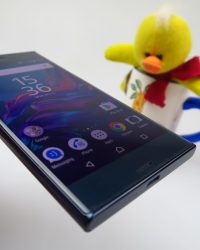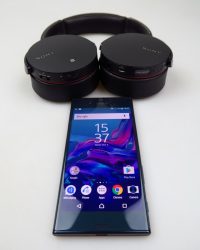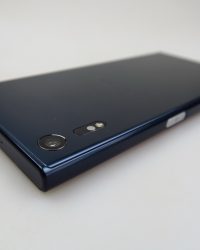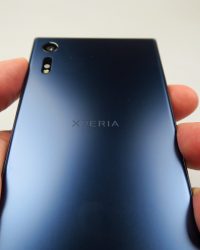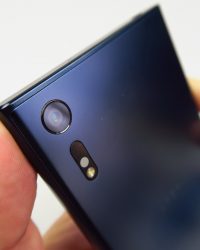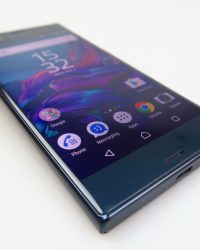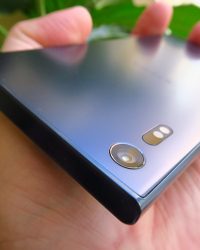The Sony Xperia XZ is Sony’s fall flagship this year, being unveiled at IFA 2016 in September. We received for testing pretty fast and this model started to grow on us fast. It’s focused on a great camera and high end specs, being sort of a cameraphone-flagship hybrid. Priced at $700, the device was launched in October all over the world and it feels like a slightly bigger Xperia X Performance.
It keeps the same CPU, RAM, Full HD screen and on paper the camera resolution, but it brings a new camera sensor. Available in black, blue or platinum, the phone has a design that’s different from all the other flagships this year. It reminds me a bit of the Nokia N9, sporting a flat top and bottom and rounded edges. It measures 8.1 mm in thickness and weighs 161 grams, meaning it’s a bit thicker than the 7.9 mm thick Galaxy S7 and also 9 grams heavier than the S7.
The weight is identical to the one of the HTC 10, just so you know. In the end, the phone feels a bit heavy, but the weight is reassuring, making the device feel solid and well built. It’s a 5.2 incher, with a great grip, a comfy Power button, but the volume buttons are placed too low on the side. This one is a long phone, that feels like a 5.5 incher rather than a 5.2 inch model.
It also comes with big bezels, including the top and bottom ones, while the one hand use isn’t plausible here. The device relies on a new type of material called Alkaleido, basically a piece of metal, that’s shaped by Sony’s equipment. The result is a matte back and the sides are covered with something that feels like plastic. The back gets smudged easily and the body is IP68 certified, meaning it’s dust and water resilient, up to 1.5 meters and 30 minutes.
Sony is doing its own thing, that’s for sure. Now we move on to the display, with a 5.2 inch Full HD IPS LCD panel and big bezels. The usual lingo is here, with the names Triluminous and X Reality being thrown around. We also get Gorilla Glass 4 protection and the video player on board of the device is filled to the brim with extras. There’s an online section, TV guide, even a sort of YouTube guide and a highlights section.
The video player also brings audio options, like DSEE HX, Clear Audio+ and Sound Effects, plus we also have subtitle settings. The viewing experience brought us a pretty deep black for an IPS LCD, oversaturated colors, good contrast, brightness and wide view angles. Pixels have an RGB Stripes setup and the luxmeter showed a value of 611 LUX, but not in an uniform fashion, so there are areas with 573 LUX or 603 LUX.
We surpassed the iPhone 6S Plus and Xiaomi Mi 5, but we scored below the OnePlus 3 and Galaxy S6 Edge+ (in the sun). Settings include Adaptive Brightness, Smart Backlight Control and Image Enhance. You can set that to Off, X Reality for Mobile (more natural colors) and Super Vivid (over saturated a bit). There’s also White Balance, with R/G/B sliders, font size options, system icons to tweak and a Glove Mode. Everything is swell, aside from the oversaturation bit.
Now let’s talk about the hardware and performance for a bit. Sony Xperia XZ opts for a Qualcomm Snapdragon 820 quad core processor, clocked at up to 2.15 GHz, with an Adreno 530 GPU, 3 GB RAM to accompany it and 32 GB of storage in the single SIM version or 64 GB in the dual SIM version. A microSD card slot is also here.
The handset has no lag and a fluid UI, but some apps tend to start slow. The games run OK, including Riptide GP Renegade and all the other titles we tried out. We also did benchmarks and in Quadrant we scored above the LG G5 and Xiaomi Mi5, which is excellent, while in AnTuTu we beat the Galaxy S7 and HTC 10, also excellent result. GeekBench 3 saw us beating the Galaxy S7 Edge in the single core sub-test and the OnePlus 3 in the multi core one.
A solid performance and no overheating here, as the device reaches 38.2 degrees Celsius after running GFXBench and 37.8 after gaming in Riptide. On the battery front there’s a 2900 mAh Li-Ion unit, with Adaptive Charging, that’s able to learn your charging habits and slow down the charging after 90% when the device is left to charge overnight.
Our HD video playback test in a loop showed us a value of 9 hours and 1 minute, which is just OK, not exactly mind blowing. It beats the Nexus 6P and LG G4, but scores below the LG V10, HTC 10 and Moto G4. In PCMark we scored a very weak 4 hours and 29 minutes, which frankly speaking can’t even be explained. For example the Huawei nova Plus scores 9 hours and it’s in a lower league than this device.
At least we beat the Huawei Honor 6 and we were just 2 minutes below the Huawei P9. Even the Amazon Fire Phone beat us. Charging is done in 2 hours and 42 minutes, which is rather long and beats the Huawei P8, but scores below the LG Nexus 5X. Battery Settings include Battery Optimization, as well as the famous Stamina, that restricts some features. It’s divided into Battery Time, Balance and Performance, depending on how much you want to drain your battery and the tasks you have ahead.
Then there’s the Ultra Stamina Mode, with no WiFi or mbile, just basic apps. We also have the Battery Care, that detects your charging pattern and adapts to it. Overall, this is an underwhelming battery, sadly. Now, on to the multimedia! Sony Xperia XZ offers dual front speakers, stereo speakers for that matter and doesn’t come bundled with headphones, although we did have the kickass Sony MDR-XB950BT headset to play with together with the device and some carriers and retailers also bundled it when selling the phone.
We can use Play Music and Music here as music players, with Music having tons of segments and options, including Spotify integration. Settings are as usual varied and a tribute to the days of the Walkman. We get a DSEE HX option to upgrade compressed music to high res one, plus Clear Audio+, Sound Effects and a 5 channel EQ with sliders.
There’s also Clear Bass with its own slider, surround sound and S Force Front Surround, plus Dynamic Normalizer. We even have an auto optimization option for headphones and a mic sensitivity option with settings like Auto, High, Medium or Low. Finally, when we actually got around to listening to the speakers we met with a loud sound, good bass and a back that vibrates a lot.
The sound is crisp and we’ve got OK high notes. The sound was great and I liked the way the surround was generated. There’s some pretty serious muffling on a flat surface. When the headphones were used, we liked the experience, particularly the bass and noise isolation.
The decibelmeter test we did didn’t confirm our impressions, as we only achieved 69.5 dBA at the back and 80.4 dBA at the front, which is just so-so, not very impressive. At least we beat the Sony Xperia X5 Premium and LG V10, but scored below the Moto G4 and Huawei P8. It’s all good, but no records are broken. And finally, here we are with the camera.
Sony Xperia XZ has a 23 megapixel camera with Triple Image Sensing tech and a 1/2.3 inch Exmor RS sensor, plus a 24 mm wide G lens and 5X Clear Image zoom. It offers F/2.0 aperture, laser focus, RGBC-IR sensor and it’s able to measure the visible color using infrared info. There’s BIONZ processing and stabilization via the Steadyshot system, on a 5 axis setup.
Predictive autofocus and a LED flash are also here. Upfront there’s a 13 megapixel shooter with 22 mm wide angle lens and F/2.0 aperture. The camera app starts off slow, but the focus speed was pretty good and zoom is fluid. Picture taking is somehow slow, for some reason. The camera UI is basically the same as on the Xperia Z5, with tons of options on offer.
There’s the main Superior Auto mode, that tells between each situation automatically, be it macro, landscape or backlight. Resolution can be set to 23 MP in 4:3, 20 MP in 16:9 or 8 MP in 4:3. There are color and brightness sliders and object tracking to set here. In Manual mode, more options are triggered, like Scene, White Balance, exposure, shutter and focus, as well as ISO and HDR.
Video can be shot in Full HD at 30 or 60 FPS, or 4K even, but that’s separate as one of the Camera Apps. Steadyshot stabilization can be set to standard,off or Intelligent Active, which is the one that really manages to make the image great. Stickers, Panorama and the other usual apps for the cam are here too. We now move on to the gallery of shots taken with this device, starting with those taken on a moderately sunny day of October.
The clarity is good and colors are realistic, plus we have excellent zoom at up to 4X, without losing too much quality. Selfies are kind of weird, because in some of the shots the background looked clearer than my face. When we managed to focus properly, we achieved excellent closeups and in general solid shots, but I’ve seen better to be honest.
It’s a bit hard to focus properly for macros and I certainly enjoyed the texture of the church building. There are also some very nice shots of a white rose in the gallery. We also spotted some dynamic range problems, especially in the shots with those metal/rock bells. Speaking of the bells, they’re very well detailed. Some HDR shots felt a bit too white, I should say. 20 megapixel shots have a ton of details and everything is crisp.
In the sun the selfies looked great and I felt as if I were using a film camera, at times. The Panorama was surprisingly modest, at 4912 x 1080 pixels. I noticed some fuzzier trees in the distance, which were a bit of a letdown. In spite of all the things I complained about before, when the camera does take a good, it REALLY takes it, managing to be on par with the best models of the year, like the LG G5, Galaxy S7 and HTC 10, plus the advantage of extra details on the generous res sensor.
I should probably also point out the fact that shots are brighter and more realistic color-wise compared to what we saw on the Xperia Z5 for example. Indoors we had some focus problems, but the colors and clarity were good. Low light capture had two phases: phase one with the yellow lights and halos that are too big, plus a bit of blur and the concert phase, that looked amazing.
So, if you’re strolling casually in the center of the town filled with yellow street lights, pictures are going to be underwhelming, but if you’re in a club or in a concert venue, the Xperia XZ is the way to go, particularly since it also has a kickass microphone, but we’ll get to that in the video area. In spite of being a great concert phone, the overall low light behaviour is inferior to the one of the HTC 10 and OnePlus 3, plus Galaxy S7.
Videos were shot with this phone in Full HD, at 30 FPPS and with a 18 Mbps bitrate. The microphone was excellent and we had good clarity and nice details when zooming in. The 4K video had a 56 Mbps bitrate and looked perfect, when it came to exposure, white balance, clarity and colors. The 60 FPS clip was cinematic and nice looking and had a 31 Mbps bitrate. There was no problem with moving subjects, luckily.
We then tried out the stabilization, with fantastic results. With the Steadyshot Standard mode, things are just OK, but with the Intelligent Steadyshot, things are out of this world. Basically, it’s as if you were using a handycam or some sort of travel rail for the professional cameras used for movies. And I’m not even kidding. You can run, walk, whatever, there’s no trembling or jerk of the image, so great filming and stabilization.
The only “problem” is that the Xperia Z5 also filmed pretty well, so aside from the stabilization, the evolution isn’t huge. When it comes to low light video capture, things got a bit yellow-ish, but the microphone was great when it came to recording that concert. Some of the footage we shot had blue-ish edges and the cam performs better with less light, when the yellow light doesn’t come into play.
There’s some focus loss happening every now and then, but if you avoid yellow light, the capture will be OK. The conclusion is that in spite of the Xperia XZ not having the best camera of the smartphone segment, it’s the champ in a few areas though: stabilization, concert filming (top 3 material), selfies, details in closeups and night time clarity.
We also tested the web browser preinstalled on the device, which is Chrome and it’s kind of slow actually, but its benchmarks are good. The virtual keyboard on the device comes courtesy of Swiftkey and features big buttons and loads of features. As far as connectivity goes, the Xperia XZ has a nano SIM card slot and comes in a single SIM or dual SIM version.
It supports LTE Category 9, HSPA+, GPS and Glonass and also comes with DLNA, Miracast, Bluetooth 4.2, NFC and WiFi a/b/g/n/ac. There’s active noise cancelling here via a dedicated microphone. Calls are lour and clear, but the voice sounds a bit metallic. A good thing I’d like to point out is the fact that in spite of having an unibody case, this model doesn’t require a metal key to access the SIM slot, instead relying on simply pulling the SIM card slot’s lid.
We also did a SpeedTest and achieved 166 Mbps in download on WiFi and 25 Mbps in upload. On 4G LTE we got up to 60 Mbps in download and 43 Mbps in upload. All of them are pretty good results. As far the OS, UI and apps are concerned, we get here stock Android Marshmallow, mixed with the Xperia UI and soon with Nougat, since Sony promised to move fast with the update.
The leftmost homescreen is dedicated to Google Now, while multitasking is done via the usual carousel. The icons are quite pretty here, flat and not very glossy, but still colorful. Pinching the screen triggers the widgets, wallpapers, themes and settings area. Widgets are nice looking and the themes remind me of the PlayStation UI.
Settings let you tweak the icon size, apply icon packs and also modify transitions. The dropdown portion includes notifications and quick settings, while the core Settings area includes no special options, aside from those associated to the fingerprint scanner. Speaking of which, this scanner has a long setup and the gesture of pressing it on the side feels very natural, accurate and fast.
Device encryption is also available. The preinstalled apps list includes quite a few names, 46 of them actually and among the most important we find PS4 Remote, AVG Lifelog, Movie Creator, News, Sketch and Spotify. And now the time for a verdict has arrived!
Here are the Pros:
- atypical design
- bright screen
- good performance
- tons of audio options
- fantastic stabilization via SteadyShot
- good selfies and clarity of main camera shots, plus details
- great microphone
- stereo speakers sound pretty solid
- no key needed for SIM slot
And the Cons:
- big bezels
- bloatware
- oversaturated screen
- underhwelming PCMark result
- not impressive audio volume
- low light photo capture is below flagships
- muffled acoustics
This remains one of the most solid cameraphones of the year, adopts an interesting design and offers great stabilization and great concert video capture. It’s going to get Nougat fast, it has great performance, especially for a 3 GB RAM phone and it’s a clear upgrade from the Xperia Z5 from last year. The performance and camera are on par with the 2016 greats and even above them in some segments.
Sony seems to be getting its mojo back finally. The Xperia XZ can be purchased here.































